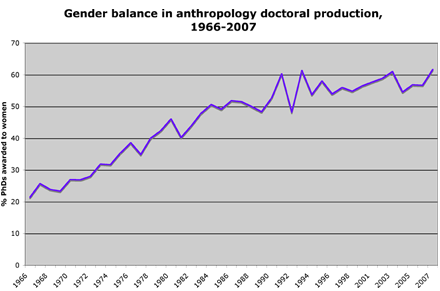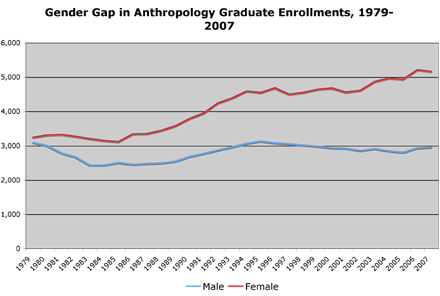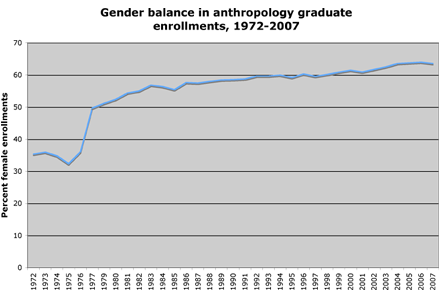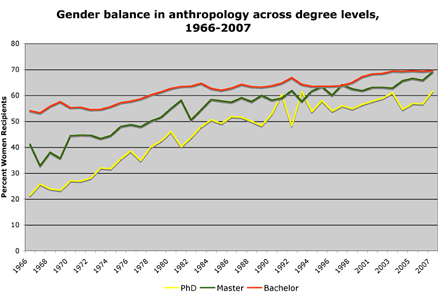
I want here to present some quick graphs that suggest the changing gender dynamics within American anthropology. This first graph shows the production of new doctorates since the 60s. It is commonly thought in the field that there has been something of a “feminization” of anthropology over the past few decades, and as we can see here, the number of doctorates awarded to women (in blue) has indeed been greater than the number of doctorates awarded to men (red) since 1992. We can see here that males were demographically dominant in the production of doctorates until 1984, after which there were eight years of approximate equality (where the two lines overlap) followed by divergence.
Important to note, it seems to me, is that although it’s true that the relative place of males and females has indeed been inverted, the overall picture here is that the two lines have risen together fairly regularly. Quite often, especially in the last fifteen years, we can see that little shifts correlate across genders, as in the little drops in 2001 and 2005. And the demographic expansion of the field in general is of a far greater demographic magnitude than the shift in gender balance. In 2007, we awarded more than five times the number of new doctorates as in 1966 (519 vs. 98) — a fact whose significance I will come back to later. But to get a better sense of changing gender ratios, consider a graph of women as a percentage of the total pool of doctoral recipients.

Since this is a graph of women as a percentage of all PhDs awarded, the 50% mark signifies the point of gender balance. As we can see, in the 1960s women comprised a fairly small minority of new doctorates, but grew fairly steadily through the 1970s, hovering around parity during the 1980s as I said above, and now comprising between 55%-60% of new anthropologists. This definitely constitutes a majority, but a far from overwhelming one. Women have not become as demographically dominant as men once were; if anything, the proportion of women among new anthropologsts may even be converging on some sort of rough slightly-majority equilibrium.
However, when we look not at doctorates awarded but at total graduate enrollments (many or most of which are at the Master’s level), we see that the gender gap has in fact been continuing to widen fairly steadily.

As above, there are some overall similarities in the graphs, some similar local maxima, but it is very clear that the number of men enrolled has been falling slightly since 1995, while the number of women enrolled has continued to increase. Compared with the previous graph, which you’ll recall dealt with doctorates awarded, this seems to suggest that there are a lot of women graduate students who don’t end up with PhDs. Or, put differently, there’s greater gender parity by the end of doctoral education than there is at the beginning stages of graduate programs. As we know, people who get doctorates have to pass through the earlier stages of graduate education. If there are proportionately more men at the later stages, that has to mean that women are disproportionately being screened out along the way.
Worth noticing, in passing, is that if we look slightly farther back into the 1970s, we can see that women as a fraction of total graduate enrollments passed the 50% mark in 1977:

So women attain parity in overall graduate enrollments in 1977, while as we saw in the first graph above, women first attained parity as recipients of anthropology doctorates in 1984. This seven-year difference is an interesting time gap because it is just what one would predict if one expected it to take about seven years on average to get a anthropology Ph.D from the start of one’s enrollment in grad school. In other words, we can see the likelihood that gender parity was reached around the time of the 1977 grad cohort, but that it then took seven years or so for this cohort to graduate.
I do have some further graphs of continuing gender imbalance in the discipline, alas. Take a look at the gender balance across different levels of degree recipients (based on degrees issued in a given year, not enrollments).

Again, the 50% line marks the point of gender parity. The top line (orange) indicates the percentage of bachelor’s degrees awarded to women; the middle line indicates the percentage of master’s, and the bottom line (yellow) indicates doctorates. Insofar as each curve here is rising, we see again that the fraction of women in the discipline has continued to increase at all levels for a long time. But we can learn two new things here.
First, on the down side, the basic demographic structure of our field has preserved a kind of masculine bias for decades — indeed, since the start of the data. In other words, men have always been increasingly well-represented the higher up you go in anthropological education. This shows again, and more clearly than above, that women have always been, one way or another, disproportionately weeded out of the ranks of new anthropologists.
Second, on the positive side, the curves do seem to be converging. The difference between the fraction of women who get bachelor’s degrees and the fraction of women who get doctorates is decreasing. My sense from this graph is that convergence was happening much more markedly through the 1980s, while since then there has been more of a steady state. (See how the curves are roughly parallel in the right-hand part of the graph? That’s what I have in mind.) This means that this demographic dominance is smaller than it used to be. A double conclusion suggests itself: while men are no longer demographically dominant, and are even a minority (remarkably so at the undergraduate level, where women receive nearly 70% of anthropology degrees), there are still gendered principles of selection at work in the field.
These lingering gender dynamics will not, of course, be a major surprise to anyone. But it’s good to have some statistical confirmation of what is intuitively viewed — somewhat paradoxically — as both an increasing feminization of anthropology and an ongoing masculine bias. That said, I would stand by my earlier remark that the most demographically striking thing here is still the overall population growth of anthropology, hundreds of percent over the decades. The effects of growth on disciplinary social dynamics are probably vast and worth much further exploration. This demographic expansion seems linked to a number of fairly important intellectual changes in the field: there are a lot more little subfields and subspecialties than there used to be; there are a lot more AAA sections than there were when the discipline was smaller and probably more socially homogenous; and there is currently perhaps less of a shared set of ongoing debates or even of a shared theoretical canon. Some professors say they don’t really know what makes something cultural anthropology anymore, and have no further sense of a shared disciplinary endeavor; old-timers sometimes conjure the nostalgic image of an earlier, pre-World-War-II era when the discipline was small enough for everyone to know everyone else. All of these, I would point out, are the subjective or experiential correlates of the objective fact of decades of vast disciplinary growth.
I do have some additional data on gender balance in other social science fields, but I’ll have to postpone that momentarily because I promised to start blogging about comparative university neoliberalisms…
This made me wonder what the gender demographics are for anthro faculty–I imagine if there are more women getting PhDs in anthro, then there are more female professors in anthro. But when I think about it, I sometimes wonder what difference it makes. I am a woman. Always will be. Can’t change that, unless I go through some radical surgical procedures, physically and identity-wise. Maybe PhD programs are like that. Surgical procedures in which, if you are a female, you get shut up, cut up, and packaged into what generally looks (and sounds) like a male anthropologist.
Being away from anthro, I am beginning to see the joys of doing womanly things and not constantly thinking to myself…”Oooo, this is such a gendered thing to do, so don’t do it ‘cuz you’re being disenfranchised by men and ugh! you’re even being complicit in the whole deal!”
I suppose my question to women in anthropology would be, “Now that you have a PhD and are a professor, tell me, just how much authority do you have? How many men truly listen to you? And what did you have to give up to get here, to this place from which you probably feel you can speak? And when you speak, what kind of squeak or squeal do you make, after you cough and cough and clear your voice and drink some bottled water? And by the way, I know you’re the Department Chair n’ all (kudos!) but you must know that everyone in the room was more interested in the way you wore your hair today and not in anything you had to say. And mmm, i just wanted to add, you’re aging gracefully. What’s your secret? Is it olive oil? Coconut oil? Papaya seeds? Something you discovered in the tropics? I wonder what you’re kitchen looks like. I wish I could really talk to you. Maybe learn a thing or two.”
🙂
hi Viola,
Yeah, I agree it would be good to look at faculty demographics too. I have to say that, although I acknowledge that I’m not a woman and that certainly affects my view of gender dynamics, I don’t think gender dynamics in anthropology are overall quite as bad as you make it seem in this comment. Although the pressure you mention for women to become honorary men undoubtedly has existed, I think it was probably far more intense a few decades ago, when (at Chicago at least) there were hardly any women faculty and gender dynamics were probably more outrageous… and though I do love your metaphor of symbolic surgery, I don’t think women anthropologists are objectified and reduced to their looks always and everywhere, today. And I kind of felt confused by your last “question to women in anthropology” — aren’t you against this kind of sexist focus on hair and skincare? Towards the end of your fictitious question for women, it sounds a bit like you’re asking women faculty just this kind of intellectually irrelevant questions yourself. Can you clarify a little?
Hi, this is really interesting. What were your data sources for the graphs?
Hi Dattergio, all these figures come from the NSF’s WebCASPAR, a site that offers a big database of national educational stats. If you poke around there, you’ll find an NSF/NIH survey on grad enrollments as well as an IPEDS survey on degree completions (ie, degrees awarded) — it should be pretty obvious from the available choice of webcaspar variables how I organized the data that corresponds to these graphs, but if you happen to be especially curious, I’m happy to email you the spreadsheets.
thanks for stopping by! eli
Came to this via SavageMinds, and hugely enjoyed your posts – this caught my eye (and moved my mouse to read the lot), but the others too. I shall get to the one on quantification and anthropology’s allergy to it in due course!
Particularly interested in the gender distribution between UG, PG and PHD in US universities, particularly your diagnosis of the apparent ‘weeding out’ of women between enrolllment and submission in the phd process. It would be very interesting to know what some of the factors are, altho partners (and their jobs) and families can’t be far from the equation. But as Viola suggests, I think it is almost more important to consider the gap between phd and tenure. Anecdotal evidence around me makes me wonder about the relationship between hiring and gender, combined with the fact that finishing phds often coincides with a shortening window to start a family, and that the phd-ing partner in a relationship may be both more able to stay the course over lengthy periods of tenure-hunting, if their partner has a well paying job -but equally, less able to move to follow job openings for the same reason.
Writing from the UK, you might be interested by a recent report by the ESRC (SSRC equivalent), done by anthropologists, looking at the destination of recent UK social science phds. While the destination of different disciplines was interesting, so was some of the more anecdotal evidence about staying in academia, and leaving it. The impact of concentrations of captial – in London (where the cost of housing vs academic salary is thought to be having an effect), and with respect to the USA (brain drain?) is interesting too. See: http://bit.ly/skFeW They only offer pre-crunched data sadly (I’d like to have seen more attention to gender again).
Seeing the topic of your research; how does all of this compare to France? When I worked in the Netherlands briefly i was struck by a graph someone had photocopied and fly-posted on a notice board which suggested that the gender disparity across faculties (by university) was stark. …That of course would also be (albeit likely controversial) a very interesting piece of number crunching to do.
I look forward to reading more!
hi C! Yes, I had been wondering when someone would point out the relationship between the changing gender balance in anthropology and family/partner relations (themselves deeply gendered, at least in the US context). Glad to have that brought up. It seems important, in particular, to think about how gender dynamics within anthropology are in part determined from the outside, such as (in this case) by expectations about having children, stable partnerships, etc. Changing gender balances at different levels of anthro education seem partly determined by these broader phenomena, which aren’t unique to the discipline. It’s often said that having children is considered more incompatible with one’s professional career for women than for men (not to mention the various potentials for unequal division of domestic labor). Of course, this kind of thing can also become an alibi that prevents further investigation into unfair gender dynamics within anthropology…
Thanks for the UK report — don’t have time to read it really right now but I was very very interested in Management and Business being — as in the US — the largest academic field in the UK (p47). Anthropology in the UK, on the other hand, appears to be one of the smallest of all social sciences… somehow this disparity doesn’t surprise me.
Your last question about France is really good and I don’t really know the answers yet, though I’m keeping my eyes open. I’ve read that the human sciences are generally majority women, at least at the level of the student body, though philosophy is more masculine. There definitely seem to be socially determined affinities between certain kinds of academic projects and certain genders — I met a small marxist group, for instance, that was almost entirely male — and apparently even research topics in philosophy are gendered (according to Charles Soulié’s 1995 study, aesthetics is apparently more feminine than canonical history of philosophy, for example). But can I get back to you about this in six months?
would love to hear what you think about quantification in anthropology. In spite of my post, I am still not too sure what to think myself!